Ancient Rome was built on the mythology of Romulus and Remus. 4th century Rome was rebuilt on top of the bones of Saints Peter and Paul, the Romulus and Remus of the Christian Empire.
Peter was Rome’s first Bishop. In the 5th century the Bishop of Rome became known as the Pope, but Peter was martyred around 67AD. Technically he never got to be a Pope. According to the Church, his earthly remains are buried under the Baldacchino, Bernini’s bronze canopy over the high alter in St Peter’s Basilica, although the exact location has never really been confirmed. There are public tours of the ancient necropolis under St Peter’s. The tour lasts about an hour and culminates at the (believed) final resting place of the bones of Peter. There are no bones in the vault but the location alone is enough to produce sanctified suspirations of wonder from the pilgrims who continue to make the journey to visit the city’s holy relics.
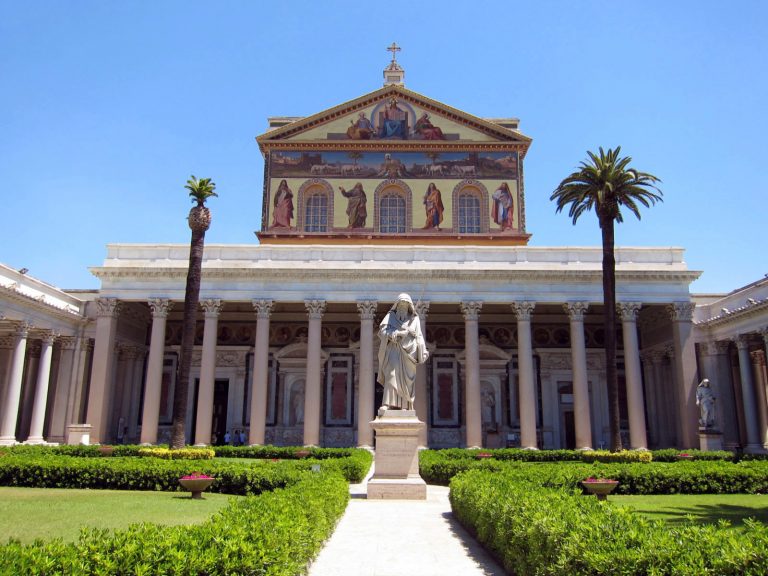
According to the Church, the remains of Paul are buried beneath the main altar of the Basilica of St Paul Outside the Walls (San Paolo fuori le Mura), a short ride on the Metro B from the central historic city.
No-one really knows how Paul died. There are no biblical or historical records. At some point early on, the Church created the story that he was beheaded under the reign of Nero. It makes a better story if the Saint died a horrible death while spreading the Gospel.
In 2009, an optical probe was inserted into a small hole in Paul’s sarcophagus. The results included bits of purple linen decorated with gold sequins, grains of red incense and a small bone fragments dated from the 1st or 2nd century. The Church was satisfied to confirm that these are the remains of Paul. By the way, it’s well worth a visit to the Basilica of St Paul Outside the Walls. Although the original 4th century church burnt down in 1823 when a workman accidently ignited the church on fire with the torch he was using to melt lead for roof repairs, the 19th century restoration is pretty close to the original design of a Roman Basilica, a public building mainly used for judicial matters.
Christian Rome wasn’t just built over the relics of Saints Peter and Paul. The city holds the largest accumulation of holy remains in the world. There are 3 types of relics; 1st class is bone or hair of the Saint, 2nd class is the instrument of torture that sent the human into sainthood and 3rd class is something the Saint had touched. Relics brought Pilgrims. Pilgrims brought money. Money brought power. Power brought people.
Let’s backtrack a little. In the year 117 AD the population of Rome was over 1.6 million. By the year 700 AD, the number was reduced to around 20,000. Emperor Constantine took a lot of the wealth (and wealthy) to his new city of Constantinople in the 4th century. The Goths took everything else and when the Aqueducts were destroyed during the Ostrogoth invasion of 537, it was pretty much the end of Rome as a livable city. Settlements were restricted to areas close to the Tiber River, an area plagued with floods, malaria and sewerage. It was not the best of times for Roman citizens.
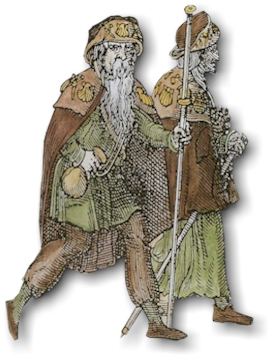 From the 6th through the 14th centuries, most of the money coming into the city was from pilgrims visiting grand Basilicas and holy relics. Bones and artifacts had magical powers. Splinters of bones were awarded to the pious and wealthy as souvenirs. Strip of cloths were lowered into the tombs, intoxicating them with the holy powers. Oil from the lamps that burned near the relics were collected in small vials and sold for heavenly sums. Bones were brought in by the wagonload. It didn’t matter who or where they came from, all that mattered was who they became.
From the 6th through the 14th centuries, most of the money coming into the city was from pilgrims visiting grand Basilicas and holy relics. Bones and artifacts had magical powers. Splinters of bones were awarded to the pious and wealthy as souvenirs. Strip of cloths were lowered into the tombs, intoxicating them with the holy powers. Oil from the lamps that burned near the relics were collected in small vials and sold for heavenly sums. Bones were brought in by the wagonload. It didn’t matter who or where they came from, all that mattered was who they became.
In 1300, Pope Boniface VIII initiated the first of the Roman Jubilee festivals. Those who came to Rome during the Jubilee and visited the great Basilicas once a day, would be cleansed of all sins. Needless to say, hundreds of thousands of people flooded into the city. Abolishing sins was good business. During the Jubilee of 1450, so many people crowded onto the Aelian Bridge (now the Ponte degli Angeli) that hundreds were trampled and hundreds more fell into the river when the balustrades collapsed.
A Jubilee was scheduled to occur every 50 years but there were some occasions when the Church needed more money they came more frequently. In some cases, Jubilees were held less than 20 years apart.
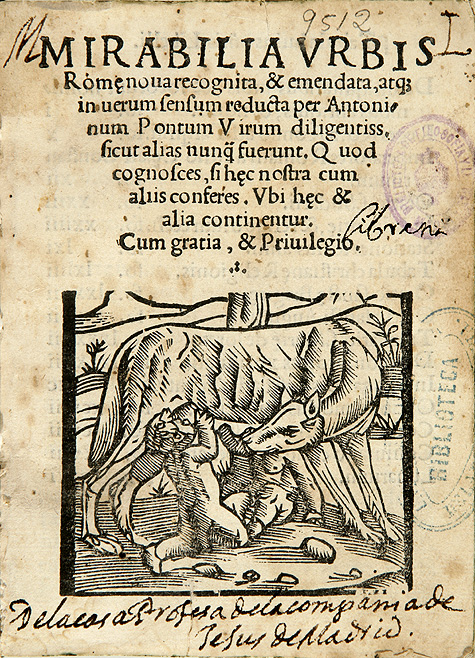 By the 12th century, the pilgrims had their first tourist guide, The Mirabilia Urbis Romae, a guide to Rome’s ancient sites, Churches and holy relics. This “first” guidebook of Rome was used well into the 15th century. The travel books of the 16th and 17th century gave birth to the “Grand Tour”, where upper class Europeans would travel to Italy in search of Classical art and culture. By the 19th century, publications like Thomas Cook and Baedeker guides became the standard of tourist travel.
By the 12th century, the pilgrims had their first tourist guide, The Mirabilia Urbis Romae, a guide to Rome’s ancient sites, Churches and holy relics. This “first” guidebook of Rome was used well into the 15th century. The travel books of the 16th and 17th century gave birth to the “Grand Tour”, where upper class Europeans would travel to Italy in search of Classical art and culture. By the 19th century, publications like Thomas Cook and Baedeker guides became the standard of tourist travel.
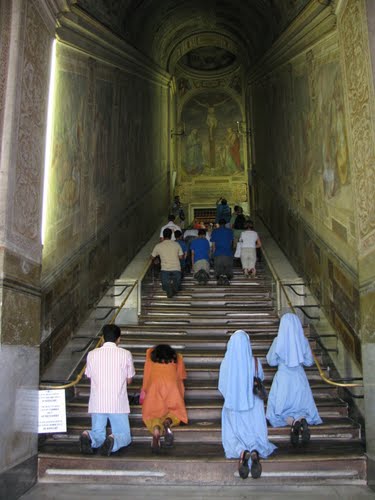 According to the Mirabilia Urbis Romae, the Basilica of St John in Lateran had a collection of relics that included the heads of Saints Peter and Paul, the Scala Sancta staircase from the palace of Pontius Pilate, the Ark of the Covenant, the rod of Aaron, the lance Longinus used to pierced the side of Christ while on the cross, some of the manna Christ fed to the masses, the tablets of the 10 Commandments, John the Baptist’s hair shirt, some of the milk from the Virgin Mary, a nightgown of the Virgin Mary, the last remnants of the loaves and fishes, thorns from the crown of thorns, and some of Christ’s blood.
According to the Mirabilia Urbis Romae, the Basilica of St John in Lateran had a collection of relics that included the heads of Saints Peter and Paul, the Scala Sancta staircase from the palace of Pontius Pilate, the Ark of the Covenant, the rod of Aaron, the lance Longinus used to pierced the side of Christ while on the cross, some of the manna Christ fed to the masses, the tablets of the 10 Commandments, John the Baptist’s hair shirt, some of the milk from the Virgin Mary, a nightgown of the Virgin Mary, the last remnants of the loaves and fishes, thorns from the crown of thorns, and some of Christ’s blood.
The (reputed) Scala Sancta, the staircase that Jesus climbed in the Palace of Pontius Pilate, is in St John’s. The others? Who knows?
St John in Lateran is just one of the Relic Burial Grounds.
The Basilica of Santa Croce in Jerusalem was built to house the True Cross brought back to Rome by Constantine’s mother, Helen in the 4th century, who’s holy bones, by the way, are interred in the Basilica of Santa Maria in Aracoeli, near the Capitoline Museum. Although most of the cross was chopped up and given to wealthy pilgrims, a few splinters still remain.
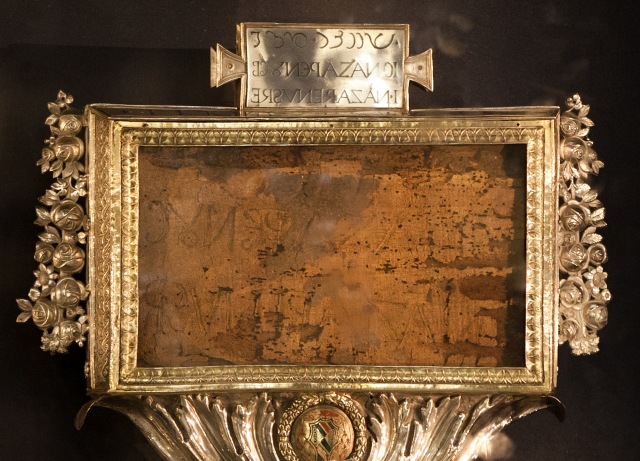 Supposedly, Helen also brought a piece of the Titulus Crucis (on view inside the Basilica). The Titulus was the title board attached to the top of the cross of Jesus proclaiming him to be the “King of the Jews”. The whole concept of the Titulus Crucis is pretty much dismissed by biblical scholars who label it just another sensational tale created to bring in tourists. In fact, the Santa Croce Titulus has actually been dated from between 980 and 1146, well over 950 years after the death of Jesus Christ. Nonetheless, it’s in the Basilica and devout pilgrims still sigh in awe under its presence.
Supposedly, Helen also brought a piece of the Titulus Crucis (on view inside the Basilica). The Titulus was the title board attached to the top of the cross of Jesus proclaiming him to be the “King of the Jews”. The whole concept of the Titulus Crucis is pretty much dismissed by biblical scholars who label it just another sensational tale created to bring in tourists. In fact, the Santa Croce Titulus has actually been dated from between 980 and 1146, well over 950 years after the death of Jesus Christ. Nonetheless, it’s in the Basilica and devout pilgrims still sigh in awe under its presence.
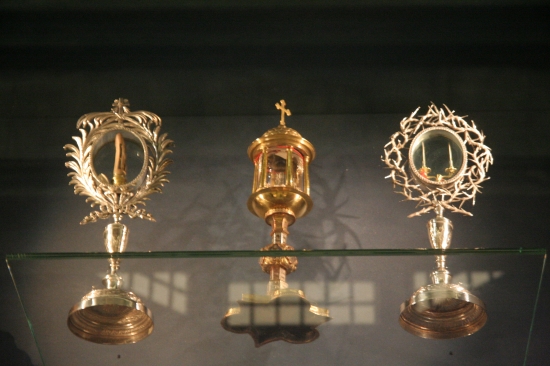 Santa Croce in Jerusalem is a great stop for the relic hungry. In the same room as the True Cross and the Titulus, you can also see a nail used to hang Jesus from the cross, a large fragment of the Good Thief’s cross, the holy sponge that was dipped in vinegar and offered to Jesus on the cross, the index finger of St Thomas, also known as doubting Thomas, a small piece of the pillar where Christ was beaten before crucifixion and 2 thorns from the crown of thorns. The last three are shown in the photo above. It’s a small chapel filled with holy memorabilia.
Santa Croce in Jerusalem is a great stop for the relic hungry. In the same room as the True Cross and the Titulus, you can also see a nail used to hang Jesus from the cross, a large fragment of the Good Thief’s cross, the holy sponge that was dipped in vinegar and offered to Jesus on the cross, the index finger of St Thomas, also known as doubting Thomas, a small piece of the pillar where Christ was beaten before crucifixion and 2 thorns from the crown of thorns. The last three are shown in the photo above. It’s a small chapel filled with holy memorabilia.
The Basilica of St Peter might be the main Basilica of the Roman Catholic Church, but compared to some others, it’s a bit lacking in great relics. Aside from the resting place of the final remains of St Peter, St Peter’s Basilica also claims to house the veil of Veronica, although some also think the veil is the holy relic is housed in a remote Capuchin Monastery in Manoppello in the Apennine Mountains.
According to the legend, after a woman named Veronica wiped the sweat from the brow of Jesus as he carried the cross on the road to Calvary, the image of his face appeared in the cloth. Many religious critics question the whole story beginning with the name. Veronica could easily be a made up word from vera (truth) and icona (icon). It’s all a little too convenient. In the words of Keith Ward, Regius Professor of Divinity at Oxford, “ Almost everybody accepts that it is a legend. I would put it on the same level as seeing the face of Mohammed in a potato.”
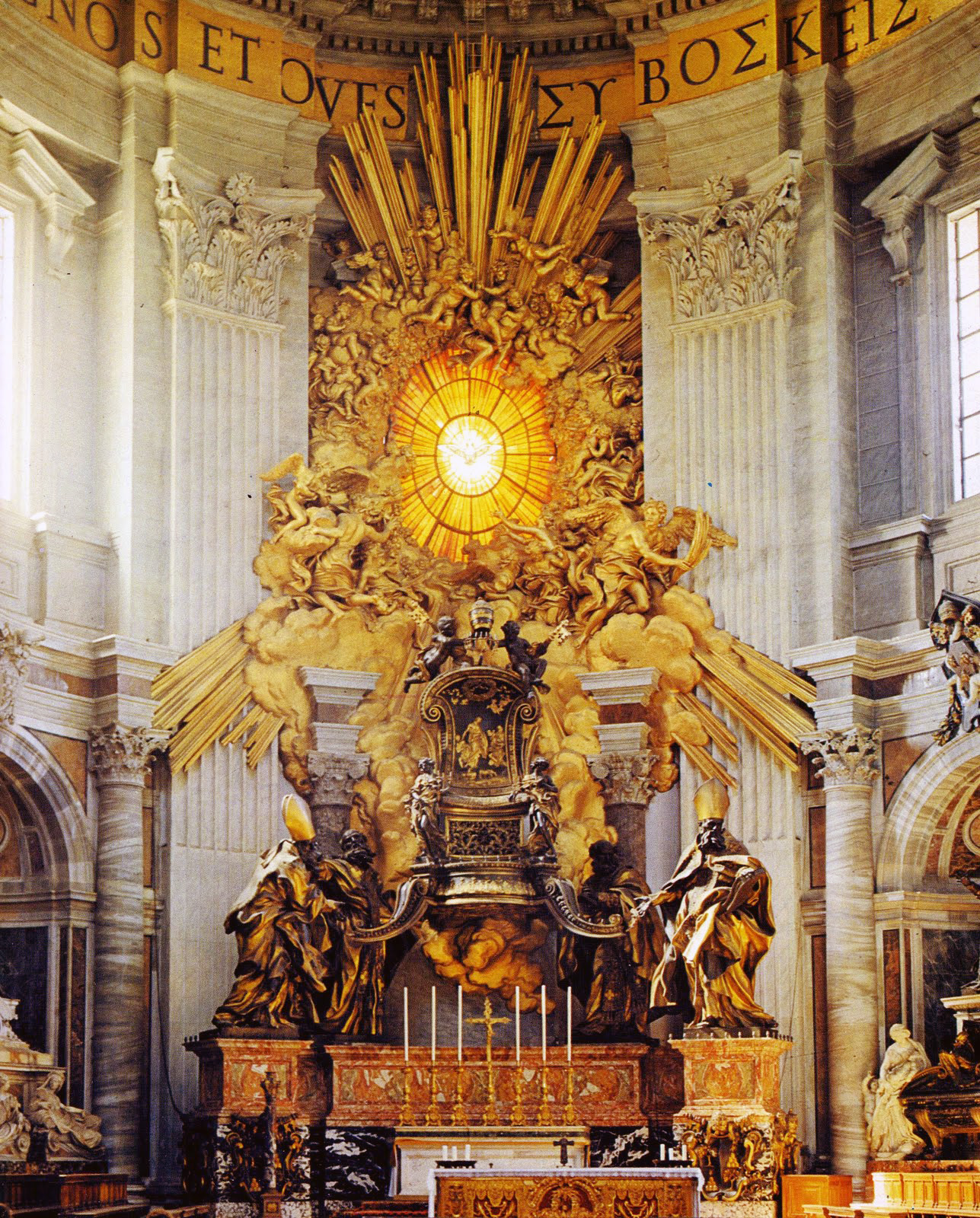 The ivory throne of St Peter (Cathedra Petri) is encased in Bernini’s fabulous bronze sculpture behind the high altar inside St Peter’s Basilica.
The ivory throne of St Peter (Cathedra Petri) is encased in Bernini’s fabulous bronze sculpture behind the high altar inside St Peter’s Basilica.
The throne was believed to be the seat of Peter when he was the Bishop of Rome and it was used by Popes well into the 17th century until it was raised to it’s current position. In reality, the chair was actually given as a gift to Papa Ioannes Octavus by the Holy Roman emperor Charles II (Charles the Bald) in 875, over 800 years after Peter’s death.
Speaking of Popes, many of them have also advanced to sainthood and consequently, St Peter’s houses a lot of holy relics in the form of Papal bones.
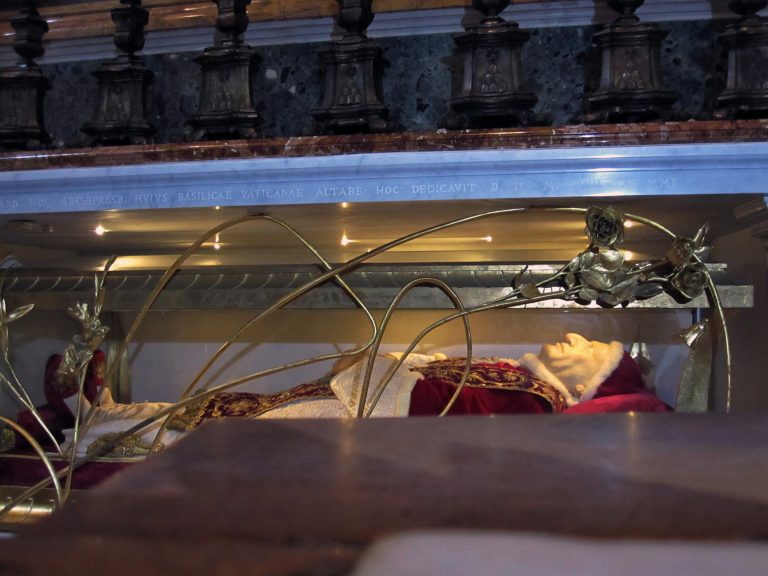
My personal favorite Pope relic is Pope John XXIII, displayed in a crystal coffin inside the Basilica in a saponified state of eternity. Pope John Paul II ordered the remains of John XXIII to be moved from the Vatican Grotto to the Basilica od St Peter’s in 2000, 37 years after his death in 1963. When the tomb was opened they discovered the body was uncorrupted. It was totally preserved. What actually happened was that the coffin was sealed so perfectly, no oxygen could get in. It was a cold humid vacuum. No oxygen, no decomposition, a perfect environment for the adipose tissue to transform into a waxy soap-like substance. Some refer to this uncorrupted state as Grave-Wax or Adipocere. Some walk by and say “isn’t it strange to have a wax sculpture of the Pope on display in the Church?”
Relic hunting in Rome can take days, even weeks.
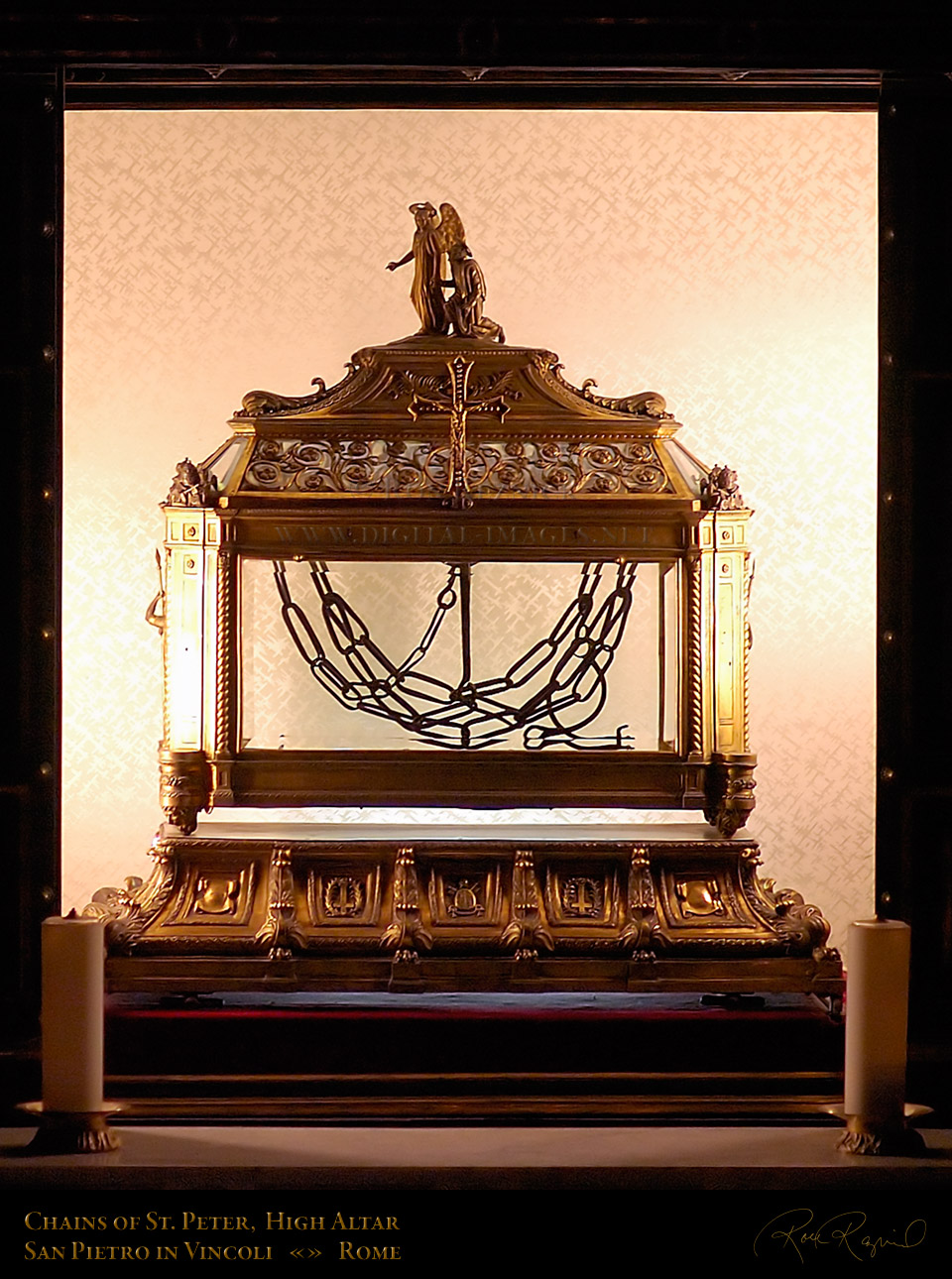 The Church of San Pietro in Vincoli, near the Colosseum, holds the Chains of St Peter. They’ve been there since the year 442. No one knows if these are Peter’s chains from his imprisonment in Jerusalem or in the Mamertine prison of Rome, or if they just another tourist hoax.
The Church of San Pietro in Vincoli, near the Colosseum, holds the Chains of St Peter. They’ve been there since the year 442. No one knows if these are Peter’s chains from his imprisonment in Jerusalem or in the Mamertine prison of Rome, or if they just another tourist hoax.
Supposedly when Papa Leo Magnus (Pope Leo I) received the two chains in 442, they magically joined together into one, and this is how they’ve appeared in the church for over 1500 years.
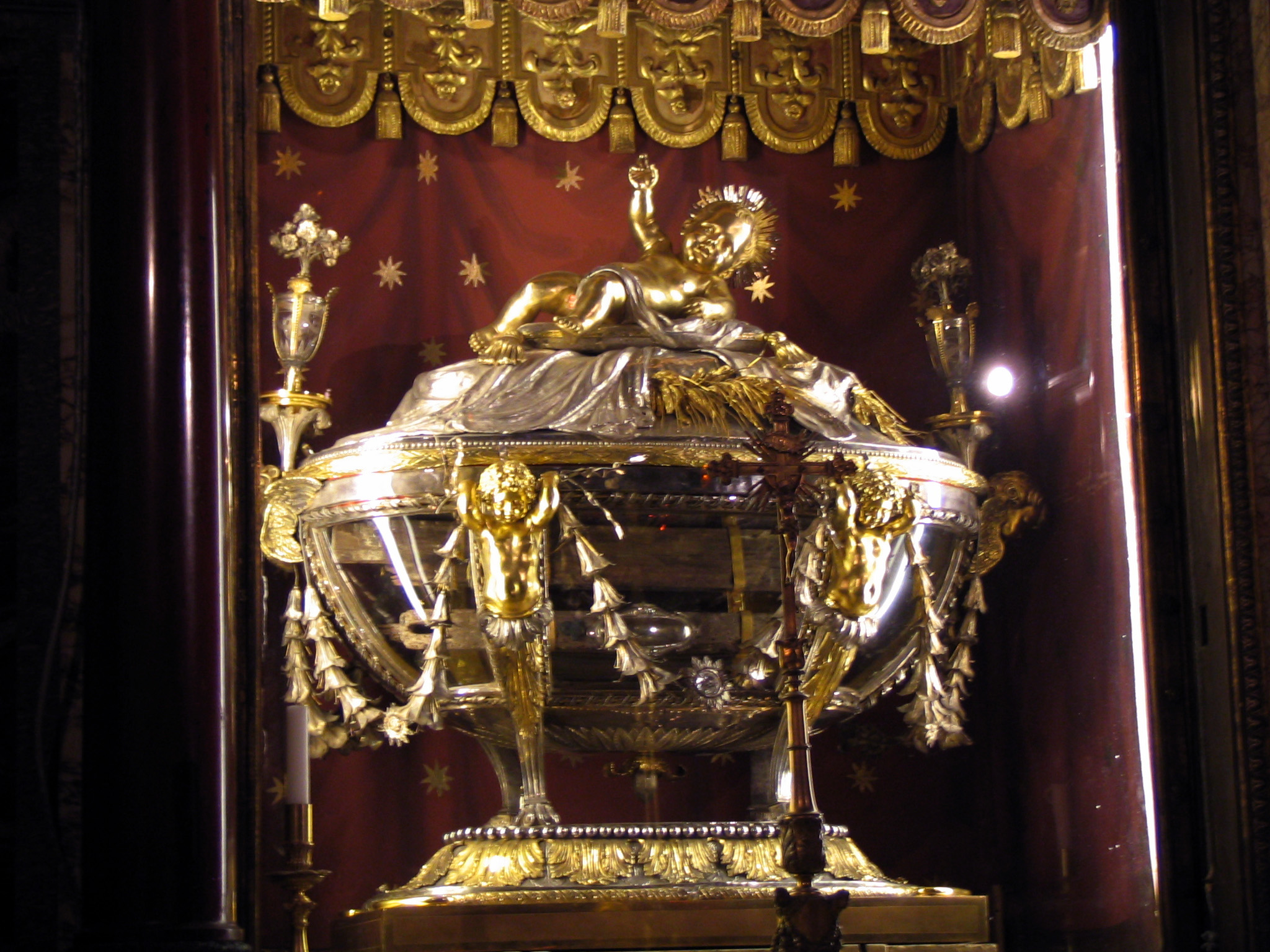 The Basilica of Santa Maria Maggiore holds the tombs of St Matthew and Saint Jerome as well as in the photo to the left, a part of the manger of the baby Jesus.
The Basilica of Santa Maria Maggiore holds the tombs of St Matthew and Saint Jerome as well as in the photo to the left, a part of the manger of the baby Jesus.
The gridiron of Saint Lawrence, where he burned to his death, is now in the church of San Lorenzo in Lucina.
The Church of Santa Maria in Cosmedin has the head of St. Valentine.
Saint Cecilia (my cover photo), the patron saint of music and another uncorrupted body, is in The Church of Santa Cecilia in Trastevere.
Saint Catherine of Siena is in the Church of Santa Maria Sopra Minerva, although her head and thumb were stolen and brought back to Siena.
 However, of all the relics I’ve seen in Rome, my personal favorite is (are) the knee prints of St Peter in the church of Santa Francesca Romana. The original 8th century Church was built into the portico of Hadrian’s 2nd century temple to Venus and Rome overlooking the ancient Forum and the Colosseum. Most of the original church collapsed along the way. The current church is from the 17th century.
However, of all the relics I’ve seen in Rome, my personal favorite is (are) the knee prints of St Peter in the church of Santa Francesca Romana. The original 8th century Church was built into the portico of Hadrian’s 2nd century temple to Venus and Rome overlooking the ancient Forum and the Colosseum. Most of the original church collapsed along the way. The current church is from the 17th century.
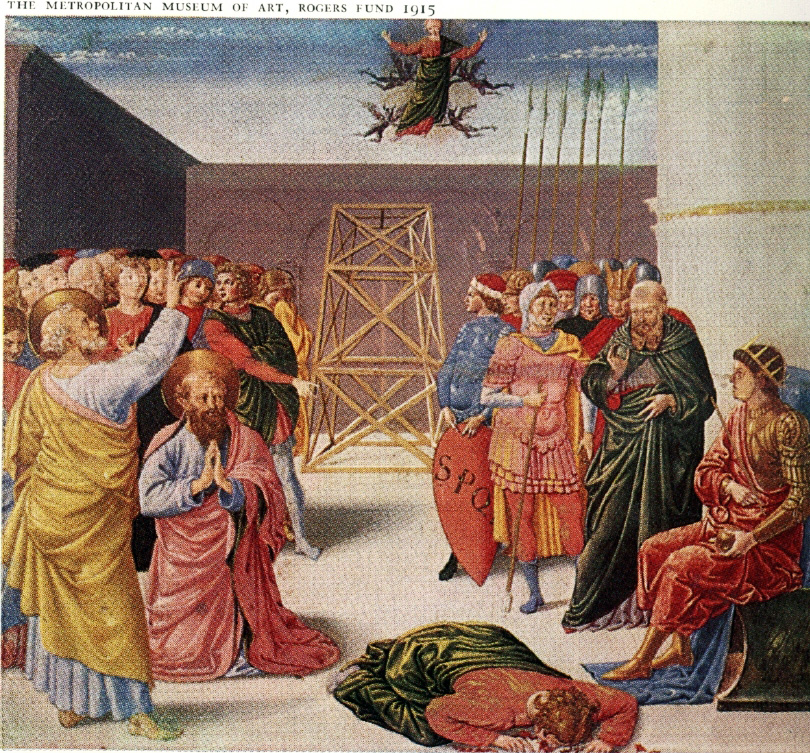 According to the legend, in order to prove to the people of Rome that his powers were greater than Peter’s, the magician Simon Magus, levitated himself high over the Forum. Peter fell to his knees in prayer to stop Simon from his power grab. He prayed so hard his knees actually embedded imprints into the volcanic basalt pavement stones of the Forum. Peter’s prayers were answered and Simon Magus fell to his death.
According to the legend, in order to prove to the people of Rome that his powers were greater than Peter’s, the magician Simon Magus, levitated himself high over the Forum. Peter fell to his knees in prayer to stop Simon from his power grab. He prayed so hard his knees actually embedded imprints into the volcanic basalt pavement stones of the Forum. Peter’s prayers were answered and Simon Magus fell to his death.
Some years later, the Holy Knee Prints were removed from the Forum and put inside the church. The church is open on Saturdays, usually in the morning. Walk to the back and look to the right. They are embedded into the concrete wall going down towards the crypt.
I would once again like to thank all those who have contributed to Google images for many of these photos. My photos include the relics of Sain Cecilia (title image), the adipocere corpse of Pope John XXIII, the knee prints of St Peter and the Basilica of St Paul Outside the Walls. I thank the various religious sites and google image photos for the rest. I encourage the use of my photos to be used in other peoples blogs and websites.
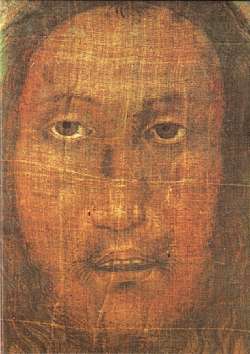
You must be logged in to post a comment.